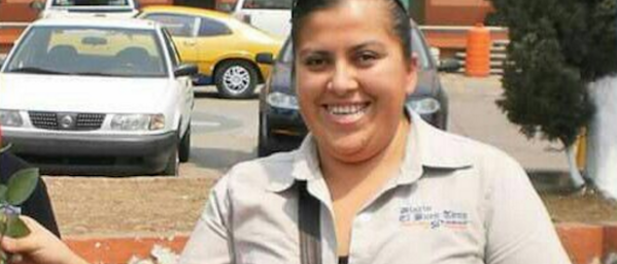
Journalist Anabel Flores. Photo shared on social networks.
Bad news for freedom of expression and the press. In the state of Veracruz [1] in the east of Mexico, journalist Anabel Flores Salazar, who according to various sources [2]was “lifted” by an armed group on 8 February 2016 and had been missing ever since, was found dead a day later. The State Commission for the Care and Protection of Journalists [3] (CEAPP) confirmed the crime reporter's killing [4] after her body was discovered in the neighboring state of Puebla.
According the blog Journalism in the Americas, of the seven journalists murdered in Mexico in 2015, three occurred in the state of Veracruz [5]. In July 2015, free speech advocate Article 19 noted that since 2000, 18 reporters have been killed in Veracruz [6], and 12 of those murders have happened during the administration of current Governor Javier Duarte.
News website Aristegui Noticias [7] was one of the first to break the news:
El cuerpo de Anabel Flores Salazar, periodista desaparecida en Veracruz la madrugada del lunes 8, fue encontrado en la carretera Cuacnopalan-Oaxaca, estado de Puebla, a unos 15 kilómetros del estado donde ejercía su profesión.
Un empleado de la Fiscalía General del estado de Puebla (FGE) confirmó a la revista Proceso la identidad del cadáver: “Ya es un hecho. Lamentablemente se trata de la reportera desaparecida la madrugada del lunes, ya se trasladó una comitiva a Puebla”.
The body of Anabel Flores Salazar, a journalist who disappeared in Veracruz in the early morning of Monday the 8th, was found along the Cuacnopalan-Oaxaca highway, Puebla state, about 15 kilometers from the state where she practiced her profession.
An employee of the Attorney General of the State of Puebla (FGE) confirmed the identity of the body to Proceso magazine: “It’s a fact. Regrettably it is the reporter who disappeared on Monday morning, and a group had moved her to Puebla.”
According the alternative news site Sopitas [8], the investigation in Veracruz had been classified in the following way:
La Fiscalía de Veracruz clasificó el levantón como “desaparición”. Al mismo tiempo el fiscal del estado, Luis Ángel Bravo Contreras, dio la orden de activar inmediatamente los protocolos especializados del Mecanismo Federal de Protección a Personas Defensoras de los Derechos Humanos y Periodistas.
The Attorney General classified the levantón as a “disappearance.” At the same time the state prosecutor, Luis Ángel Bravo Contreras, gave the order to immediately activate the specialized protocols of the Federal Mechanism for the Protection of Human Rights Defenders and Journalists.
In Mexico they utilize the word levantón when referring to incidents in which a person has been illegally deprived of their freedom by criminals or members of any of the armed groups that make up part of the internal conflict [9] plaguing the country.
Newspaper La Jornada collected eyewitness accounts [10], from which it can be deduced that the people who kidnapped Flores “seemed like soldiers” and allegedly drove military trucks.
On Twitter, user Benito Taibo vowed to keep her memory alive:
Anabel Flores. Periodista veracruzana asesinada.
Que no se nos olvide su nombre.— Benito Taibo (@benistofeles) February 10, 2016 [11]
Anabel Flores. Murdered journalist from Veracruz. We will not forget her name.
While Claudia Pérez Sosa condemned the journalist’s murder:
confirman el vil y cruel asesinato de Anabel Flores … #YaBasta [12] #NoMasViolencia [13] QEPD
— Claudia Perez Sosa (@Ex_zorrita) February 10, 2016 [14]
The vile and cruel killing of Anabel Flores has been confirmed. #EnoughisEnough #NoMoreViolence RIP
Veracruz has been an extremely risky place for journalists in recent years. Suffice it to mention the example of Gregorio Jiménez de la Cruz [15], who two years ago was stabbed and then buried in one of the clandestine graves that abound in the country. The risk for journalists, sadly, is not confined to Veracruz. In 2015, Reporters Without Borders named Mexico the country with the highest murder rate of journalists in the western hemisphere [16].
The 2015 World Press Freedom Index [17] paints a picture of this ominous Mexican landscape:
Asesinatos, secuestros, agresiones y amenazas se multiplicaron en un clima de impunidad casi total, lo que generó miedo y autocensura. La colusión de ciertas autoridades políticas y administrativas con el crimen organizado obstaculiza el buen gobierno y la justicia a todos los niveles en el país. El Mecanismo para la protección de periodistas y defensores de los derechos humanos no posee la eficacia ni la rapidez que se requieren para responder a las necesidades de los periodistas que se encuentran en peligro.
Murders, kidnappings, physical attacks and threats go almost entirely unpunished, fuelling fear and self-censorship. Collusion between organized crime and certain politicians and local officials hampers good governance and justice at all levels. The federal mechanisms for protecting human rights defenders and journalists are not effective or rapid enough to meet the needs of endangered journalists.
Last year, Rubén Espinosa, a photojournalist who fled Veracruz after reporting being subjected to threats by Governor Javier Duarte [18], was also tortured and executed [19]in a violent case that still has not been solved or prosecuted by Mexico City officials.
Javier Duarte, who belongs to the ranks of the ruling Institutional Revolutionary Party [20] (PRI), has a rocky history [21] with the local press for these and other events. Furthermore, he has shown interest in restricting the freedom of expression through the so-called “Duarte Law,” which sought to criminalize the dissemination of rumors on social networks. This was subsequently declared unconstitutional [22] by Mexico’s judicial system.
Famed writer Guadalupe Loaeza rebuked the regional governor:
Que tal duerme por las noches, señor Gobernador de Veracruz? https://t.co/Gs40lklBuz [23]
— Guadalupe Loaeza (@gloaeza) February 10, 2016 [24]
How do you sleep at night, Mr. Governor of Veracruz?
Duarte, on his part, has declined to address this new episode of violence against the journalistic profession.